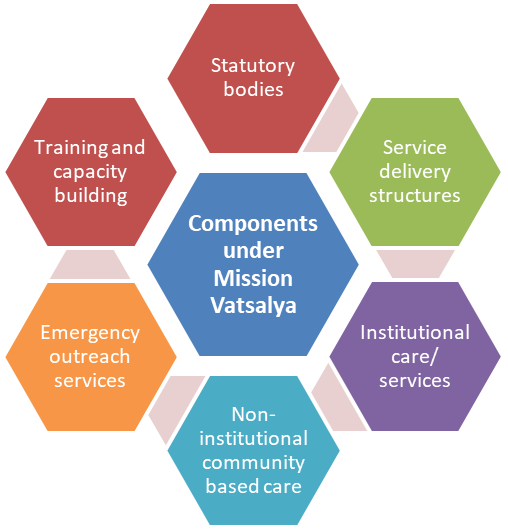Mission Vatsalya
2022 JUL 16
Mains >
Social justice > Human Resources > Women and Child issues
IN NEWS:
- The Ministry of Women and Child Development has issued guidelines for Mission Vatsalya.
BACKGROUND:
- For effective implementation of various schemes and programmes of the Ministry of Women and Child Development, all major schemes of the Ministry have been classified under 3 umbrella schemes:
- Mission Poshan 2.0: consist of efforts towards Integrated Nutrition Support
- Mission Shakti: consist of schemes and policies for the empowerment and protection of women
- Mission Vatsalya: for child protection
- Prior to 2009-10, there were three schemes being implemented under the Ministry for child protection:
- Programme for Juvenile Justice for Children in need of care and protection, and Children in conflict with Law
- Integrated Programme for street children
- Scheme for assistance to homes for children (Shishu Greh)
- All the three schemes were incorporated in a single centrally sponsored scheme called the Integrated Child Protection Scheme (ICPS). The ICPS was implemented by the Ministry since 2009-2010.
- The scheme was then renamed as “Child Protection Services” Scheme in 2017.
- The CPS Scheme has been now subsumed under Mission Vatsalya from 2021-22 onwards.
MISSION VATSALYA:
- It is an umbrella scheme for child protection services in the country.
- The objective of Mission Vatsalya is to:
- Secure a healthy and happy childhood for every child in India
- Foster a sensitive, supportive and synchronized ecosystem for development of children
- Assist States/UTs in delivering the mandate of the Juvenile Justice Act 2015
- Achieve the SDG goals
- Mission Vatsalya promotes family-based non-institutional care of children in difficult circumstances based on the principle of institutionalization of children as a measure of last resort.

- Mission Vatsalya will be implemented as a centrally sponsored scheme.
- Under child care institutions, the ministry has also announced Vatsalya Sadan which will be an integrated home complex, children home, observation home, special home and place of safety.
SIGNIFICANCE OF MISSION VATSALYA:
- Consolidated approach:
- The mission brings together various measured aimed at ensuring children’s right to Survival, Development, Protection and Participation under a single unit.
- Eg: Ministry has unified all its efforts for children in difficult circumstances which include missing, orphaned, abandoned, and surrendered children.
- Coordination of efforts:
- One of the key objectives of the mission is to ensure appropriate inter-sector response, coordinate and network with all allied systems to promote convergent efforts for seamless service delivery to children.
- Eg: Four existing portals – TrackChild (for missing/found children), CARINGS (for the adoption of children), ICPS portal (for monitoring the scheme) and Khoya-Paya (citizen-centric application for missing and sighted children) will now be integrated by the NIC under one single portal.
- Involvement of private sector:
- The mission objectives states encouraging private sector partnerships and interventions to support children within the framework of law.
- Capacity building:
- It will engage community at all levels as stakeholder in ensuring the best interest of children.
- The mission will also take measures to raise public awareness, educate public about child rights, vulnerabilities and measures for protection sponsored by government.
- Focus on local bodies:
- The mission will encourage the participation of Panchayats and Municipal Local Bodies for sustained assessment of the issues deserving attention, implementation of appropriate interventions, regular monitoring to develop a robust social safety net for children.
- Quantitative monitoring:
- The mission seeks to monitor progress on objective parameters against well-defined outputs and outcomes.
OTHER CHILD PROTECTION MEASURES IN INDIA:
- The National Children Policy, (as revised in 2013), and the National Plan of Action for Children, 2016 laid down the policy framework for child welfare and protection.
- The Juvenile Justice (Care and Protection of Children) Act 2015:
- The Protection of Children from Sexual Offences Act 2012:
- The Commissions for Protection of Child Rights Act, 2005:
- The Prohibition of Child Marriage Act, 2006:
- The Right to Education Act 2009:
- It has provisions such as:
- Primary education to all children aged 6 to 14 years.
- 25% reservation for disadvantaged sections of the society such as SCs, STs, Socially Backward Class and Differently abled
- Provisions for a non-admitted child to be admitted to an age-appropriate class.
- Prohibition on matters such as Physical punishment and mental harassment, screening procedures for admission of children, Capitation fee and Private tuition by teachers.
- Norms and standards related to Pupil Teacher Ratios, Buildings and infrastructure, School-working days etc.
- International treaties:
- India is a signatory to important international treaties such as the United Nations Convention on Rights of Child and the Hague convention on Adoption of children which mandate systemic development and strengthening of juvenile justice system in the country.
PRACTICE QUESTIONS:
Q. Enumerate the various measures taken by the government in ensuring the protection and development of children, with special reference to Mission Vatsalya?
